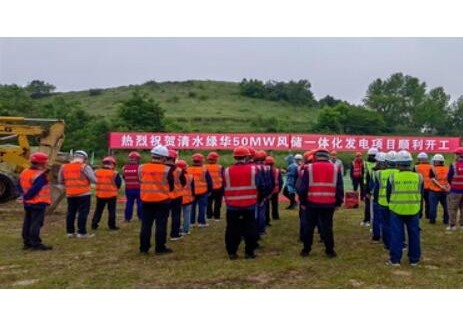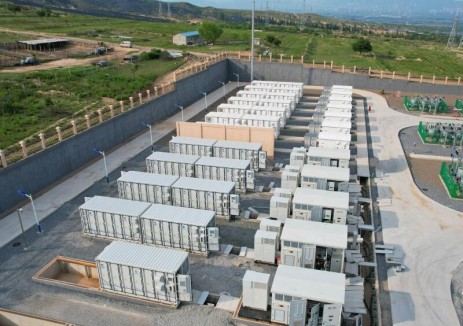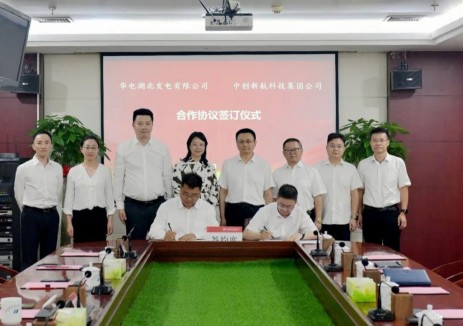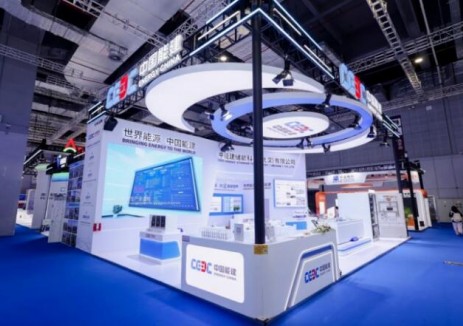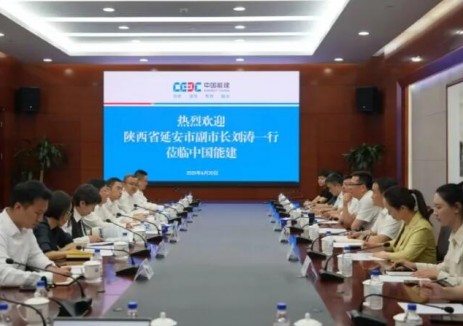每年,海洋浮游植物将大约500亿吨溶解的无机碳转化为颗粒和溶解的有机碳,其中一部分通过生物碳泵出口到深处。尽管海洋净初级生产在通过碳固存调节大气二氧化碳和维持海洋生态系统方面发挥着重要作用,但模型预测的海洋净初级生产的未来变化即使在变化的迹象中也是高度不确定的。在这里,韩国釜山国立大学基础科学研究所气候物理中心KWON教授等使用地球系统模型表明浮游植物在磷酸盐胁迫条件下节俭利用磷可以过度补偿先前预测的21世纪由于海洋变暖和分层增强而导致的下降。作者的研究结果得到了夏威夷海洋时间序列计划的观察结果的支持,表明亚热带海洋的养分吸收可塑性在维持浮游植物生产力和碳出口生产方面起着关键作用。
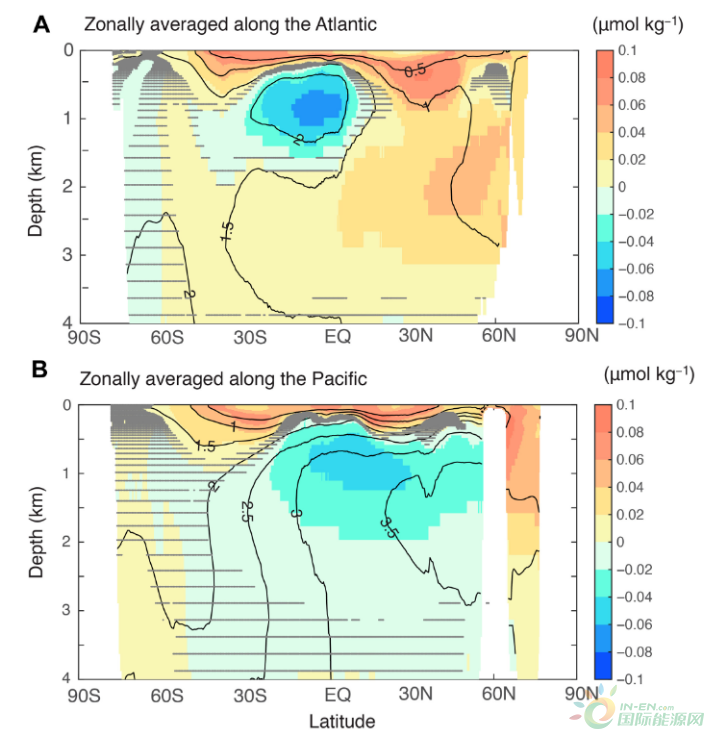
图文解读
1989-2019年,包括浮游植物和非生物物质在内的顶部125 m上平均悬浮颗粒碳(PC)和颗粒磷(PP)的浓度表现出较大的时间波动。不幸的是,由于2011年11月开始对PP分析方法进行了修改,因此无法评估PP的长期趋势及其与PC浓度的比例。然而,记录表明,悬浮颗粒C:P比的年代际变化与环境PO的变化呈负相关,当每月数据用 12 个月移动平均线平滑时(图 1A)。特别是,2002-2009 年异常低 PO 的延长时间段4浓度与悬浮颗粒相对于C在P中耗尽的时期一致(图1A)。C:P 比率对 PO 的总体灵敏度增加4基于悬浮颗粒C:P比值和环境PO浓度的全球尺度空间分布,ALOHA站的减少介于经验推导的双曲关系和幂律关系之间(图1、B和C)。C:P比对上层海洋平均PO的依赖性4浓度也适用于150米处的下沉颗粒(图1D),上部和下部真光区的浓度几乎相同(图1D)。C:P比率与PO之间的反比关系4位于北大西洋亚热带环流的百慕大大西洋时间序列研究(BATS)的时间序列数据也支持浓度(图1B和D)。这些经验关系可能反映了浮游植物C:P与PO比率的大规模响应4可用性,整合生理和生态响应,如P保留效应,包括较低的P储存,磷脂中P的硫取代和浮游植物群落转移。
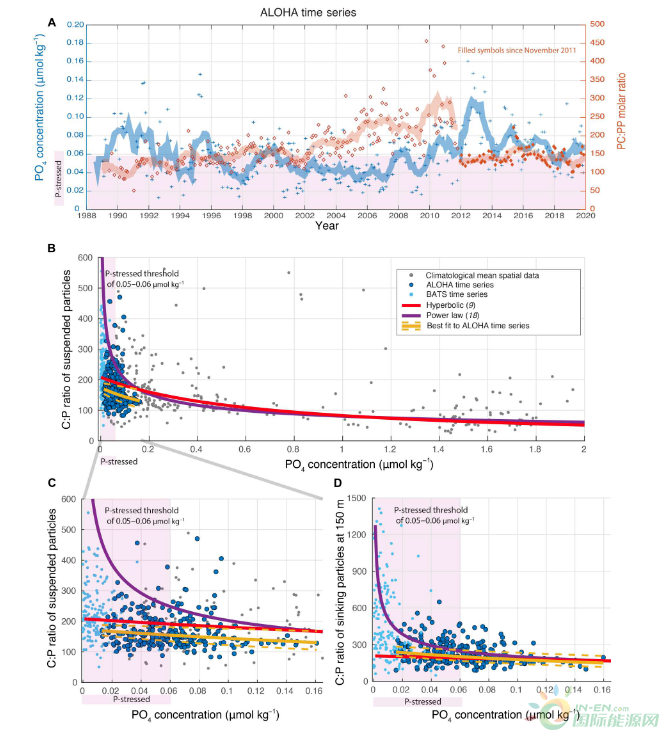
Figure 1. Relationships between surface PO4 and the C:P ratio of suspended and sinking particles.(A) Time series of monthly mean PO4 concentrations (blue) and the ratio of PC concentration to PP concentration (red) averaged over depths of 0 to 125 m at Station ALOHA. The C:P ratios before November 2011 (a time of PP measurement method change) are shown as open diamonds, and those since November 2011 are shown as filled diamonds. Shaded red and blue lines are 12-month moving averages of the respective monthly mean data. The PO4 concentrations lower than a P-stressed threshold of 0.06 μmol kg?1 are shaded in purple. (B) Scatter plot showing the C:P ratios of suspended particles in the y axis and the surface PO4 concentrations in the x axis. The ALOHA time-series data [presented in (A)] are shown in dark blue dots. The climatological mean spatially distributed data (gray dots) are taken from (32) and (33). The BATS time-series data are taken from (15) and plotted in sky blue dots. The two empirical relationships previously derived on the basis of the spatial data are shown as red [hyperbolic; Galbraith and Martiny (9)] and purple [power law; Tanioka and Matsumoto (18)] lines. The best fit to the ALOHA time-series data, P:C = (12.2 ± 7.4)‰ (per mil) × [PO4] + (5.8 ± 0.5)‰, is shown in yellow solid line with an SE denoted as yellow dashed lines. (C) Oligotrophic portion of (B) is zoomed in. (D) Scatter plot showing the C:P ratios of sinking particles at 150 m in the y axis and the surface PO4 concentrations in the x axis. The best fit to the ALOHA time-series data is P:C = (17.2 ± 8.3)‰ × [PO4] + (3.9 ± 0.5)‰.
作者基于以下关于浮游植物C:P组成的假设进行了三个数值实验:(i)全球均匀的C:P比值为117(称为“固定”实验),(ii)与PO的双曲关系的变量C:P4(称为“双曲线”实验),以及 (iii) 变量 C:P 依赖关系,表示为与 PO 的幂律关系(称为“幂律”实验)。在所有实验中,浮游植物的C:N比率固定为7.3(40),根据可变的C:P比率,导致实验中的浮游植物N:P比率范围。作者假设简单的经验关系在21世纪所有浮游植物功能类型(例如,大型和小型浮游植物和重氮生物)的元素组成变化成立。尽管这一假设需要通过未来基于现场和实验的研究来验证,但Moreno等人表明,考虑多环境因素的基于生理特征的模型产生的全球碳循环对P可用性的大规模敏感性可以通过简单的PO4基于参数化模型,只要简单参数化受当前可用观测值的约束。此外,观察证据和培养实验支持营养供应在浮游植物细胞和群落的元素分配中的关键作用,证明了作者对PO4作为浮游植物C:P可塑性的关键驱动因素。作者认为基于双曲线的经验关系是浮游植物C:P比值与PO4观察到的响应的最佳近似值变化,因为它接近时间序列数据的最佳拟合(图1)。与固定浮游植物C:P的假设情况进行比较,将使作者能够探索浮游植物C:P塑性在碳循环中的作用。作者还使用基于幂律的经验关系,可能提供C:P灵敏度对PO4的上限耗竭,作为浮游植物C:P未来合理变化的不确定性的衡量标准。
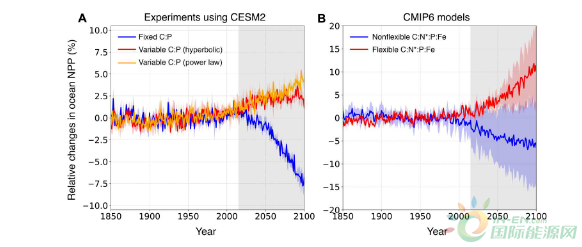
Figure 2. Relative changes (with respect to 1850–2014 means) in the globally integrated ocean NPP with time. (A) Relative changes in NPP from the variable C:P experiment with an assumed hyperbolic relationship (red), the variable C:P experiment with an assumed power-law relationship (orange), and the fixed C:P experiment (blue). Solid line represents the average of three ensemble members for each experiment, and shade represents one SD. The projection period starting from 2015 is shaded in gray. (B) Relative changes in NPP from the CMIP6 models that allow flexible phytoplankton C:N*:P:Fe ratios (two models; table S1) are shown in red, with line denoting a multimodel average and shade denoting one SD. NPP changes from the models that do not allow flexible phytoplankton C:N*:P:Fe ratios (eight models; table S2) are shown in blue.
由此产生的海洋NPP预测对寡营养区浮游植物C:P假设高度敏感。与大多数先前的地球系统模型预测一致,具有固定C:P的模拟显示,从1850年到2100年,全球一体化海洋NPP的未来将大幅下降约8%(图2A)。全球规模的NPP减少主要是由于覆盖全球海洋表面积~40%的寡养环流(图3F)中的NPP下降引起的(寡营养环流定义为模拟的当今海洋表面PO4浓度小于 0.2 mmol m?3; 图 3C)。南大洋和赤道太平洋东部核电厂的增加部分抵消了这一负面趋势(图3F)。当作者假设变量C:P时,全球一体化的海洋NPP增加,逆转了从固定C:P情况下获得的NPP下降迹象(图2A)。增加的NPP趋势主要是南大洋和赤道太平洋东部地区NPP的增加(图3H),其中增加的光可用性和温度有利于浮游植物的生长。另一方面,NPP在1850年至2100年的低营养环流中相对于当今条件几乎保持不变。该模型模拟了北大西洋的负NPP趋势,在固定C:P情况下(图3F)比变量C:P情况(图3H)更明显。北大西洋核电厂的减少与大西洋经向翻转环流的减缓有关,这也体现在这里介绍的CESM2模拟中。
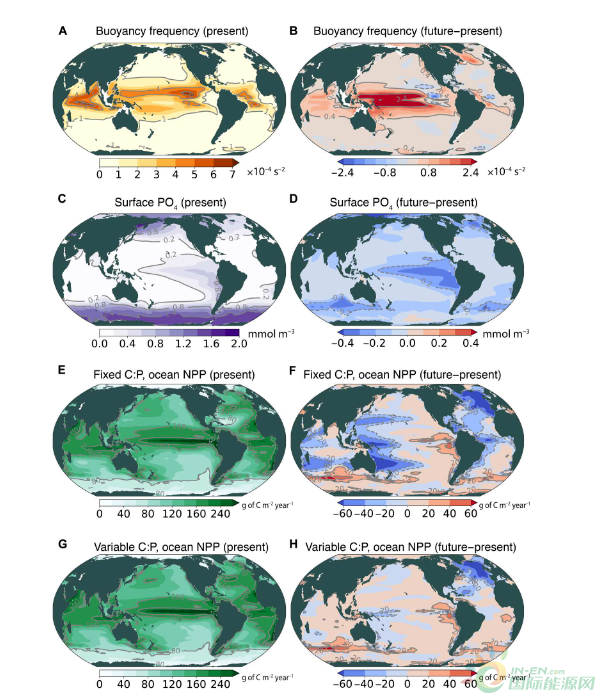
Figure 3. Present-day means and future changes in ocean stratification, phosphate concentrations, and NPP. The panels on left column (A, C, E, G) show present-day means (1990–2010 average) and those on the right column (B, D, F, H) show future changes (2080–2100 average minus 1990–2010 average). (A and B) Buoyancy frequency (a measure of stratification) at 100 m. Estimates from the fixed C:P experiment are shown. (C and D) Simulated surface PO4 concentrations from the fixed C:P experiment. (E and F) Vertically integrated ocean NPP, simulated from the fixed C:P experiment. (G and H) Vertically integrated ocean NPP, simulated from the variable C:P experiment with a hyperbolic relationship between phytoplankton C:P and PO4 concentrations.
因此,固定和可变C:P假设之间预测的NPP变化的鲜明对比发生在寡营养环流中,其中可变C:P模拟中的2080-2100年平均NPP比固定C:P模拟大三倍(图4,A至C)。在低纬度地区,增强的海洋分层导致表面PO4的大幅减少响应温室变暖的可用性(图3,A和D)。然而,在越来越多的PO4-下,浮游植物C:P比率升高胁迫条件过度补偿了养分胁迫对浮游植物生长和NPP的影响,如作者对可变和固定C:P实验之间模拟差异的分解分析所示。这种补偿使浮游植物在温暖的气候中保持持续的生长速度和NPP。低纬度地表PO4降低下的强化生物碳泵浓度与先前基于盒子模型的研究在质量上一致。
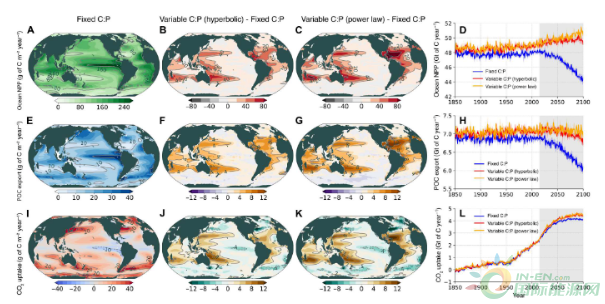
Figure 4. Future projections (2080–2100 averages) from the fixed C:P experiment and differences between variable and fixed C:P experiments. (A) Future averaged, water column–integrated NPP, simulated from the fixed C:P experiment. (B) The NPP difference between the variable (hyperbolic) and fixed C:P experiments. (C) The NPP difference between the variable (power law) and fixed C:P experiments. (D) Globally integrated ocean NPP from three experiments. A three-member ensemble average is shown as solid line, and one SD is shown as shade. (E to H) Same as (A) to (D) except that the vertical export of particulate organic carbon (POC) at 100 m is shown. (I to L) Same as (A) to (D) except that the oceanic uptake of atmospheric CO2 is shown. Positive values indicate fluxes into the ocean.
总结
显然,浮游植物已经采用了生化和生理策略来应对不断变化的物理和化学特性,这些特性已经进化了数百万年的地球历史。虽然作者在这里表明,在限制浓度下,体积细胞C:P比率可能会增加,但在P应激系统中生存的另一种策略可能是吸收额外的P,超过生长和繁殖所需的P,并将其储存为多磷酸盐,以便在P稀缺期间后续使用。这些生理过程,以及浮游植物C:P的相互作用温度和营养供应控制,可能以不一定与表面PO4之间假设的当代关系一致的方式演变浓度和浮游植物C:P吸收,可能产生额外的不确定性,超出此处讨论的那些。其他不确定性来源包括对所有浮游植物功能类型的C:P响应的假设和固定浮游植物C:N的假设,所有这些都可能导致每种浮游植物功能类型对模拟NPP响应的相对贡献的不确定性。海洋异养生物和食物网将如何响应不断变化的浮游植物C:P比率以及它们如何反馈营养循环也仍然是高度不确定的。未来的地球系统模型将需要包括更多基于机械和观测的浮游植物养分吸收可塑性和随后元素循环的参数化,因为化学计量可塑性是更现实地预测未来气候-海洋生物相互作用变化的关键。


